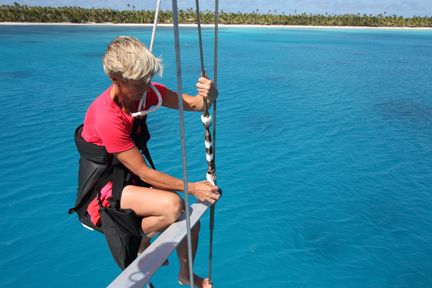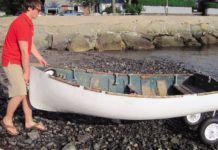Going Aloft Sans Butterflies
When going aloft, you can save yourself a lot of worry and hassle by taking a few simple steps: Harnesses: Although not as comfortable as traditional chairs, harnesses bring you closer to the top of the mast and are more secure. Wear long pants and good shoes. Halyards: Use two halyards-one primary, one safety. One should be an external halyard on a ratchet block leading from your harness back to you, so that you can have control over your own safety and ascent/descent. Shackles and winches: Dont rely on snap shackles or self-tailing jaws on winches. To attach the halyard to the harness, use locking screw-pin shackles or a buntline knot, which brings you closer to the masthead sheave than a bowline.
Tips on Caring for Marine Canvas
Canvas dodgers and biminis are the hallmark of a cruising yacht, keeping the sun at bay and allowing the crew to dodge the worst of the weather. On board, canvas also protects sails, windows, and machinery. Collectively, these represent a substantial financial investment, and we wanted to find the best way to protect the investment and get the most life out of the canvas.
Stop Boat Mattress Cushion Mildew
If you have a damp interior—as frequently happens in tropical locations or during long runs of humid weather—the bottoms of your boat mattresses may...
Preparing Your Boat for a Tropical Storm
Hurricane season is off to an early start this year. Tropical storm Elsa, the first tropical storm of the season to make U.S. landfall this season reminds us it's never too early to have a plan in place. If you haven't given storm preparation a thought yet, a good start would be our report, Lines, Snubbers, and Other Gear for Battening Down Ahead of Storms (PS July 2008). Safety expert Ralph Naranjo's first-hand account of his storm preparations Tropical Storm Dos and Donts and How to Help Your Boat Survive A Major Storm should also be required reading.
Affordable Sunglasses for Sailors
I gave up buying expensive sunglasses years ago, when I kept losing them. But I do care about getting good protection. Fortunately, having shepherded at least four different sunglass tests onto the pages of Practical Sailor, I’ve learned that you don’t need to spend a fortune to get a good pair of shades that will protect your eyes and meet nearly all of your on-the water needs. With summer in full swing I thought a summary of our past findings would be helpful for those of you who—like me—just watched as another pair of drug store sunglasses descended into the murk beneath your boat slip.
Staying Cool on the Water
As the first of what will likely be many heat-waves this summer is driving many people indoors, it is a good time to make sure that you are well-equipped to deal with the soaring summertime temperatures. Fortunately, summer temperatures are almost always cooler near the water. Which is good, since we doubt many our readers would skip sailing just because it's hot out.
During our decade of cruising, my partner and I spent most of our days within 20 degrees of the equator. In many tropical ports the temperatures pushed to almost unbearable levels. I recall specifically the Solomon Islands, Guam, and Thailand, where the glue holding my shoes together literally melted. Over time, we adapted some effective strategies for staying cool. Scrolling through the archives, I was able to find several articles to help us all ease into the season of heat.
What Dog Breed is Best Suited for Cruising?
Despite their anatomical handicaps, some dog breeds are pretty well adapted to boats and the water. The dog lovers among our readers have helped us put together this list of relatively small dogs, good traveling dogs that like the water and are happy to curl up in tight spaces during passages. Here is a list of the most popular breeds that were recommended.
Make Your Own Dinghy Wheels
As refit projects keep us busy in the boatyard, we find ourselves rifling through back issues looking for buried do-it-yourself gems. This week's blast from the past is a real back saver. Practical Sailor contributor David Liscio describes how to turn some scrap plywood, a few screws, and a lawnmower axle and wheel set into durable and inexpensive portable dinghy wheels.
The Pitch for Summer Sailing Camps for Children
Perhaps you are on the fence this summer. The drive is too far, the cost too high, or the child says, It doesn't sound like much fun. There are a million reasons to encourage your child (or grandchild) to sail this summer. Here are a few that I like.
Pondering Options for Varnishing a Mast
One of the most common questions we get regarding marine varnish is what kind of finish is best for a mast. Even though aluminum has long since replaced Sitka spruce as the material of choice for a sailboat mast, there is no shortage of boats that still have wooden masts. Many of the Taiwanese-built boats of the 70s and 80s had wooden masts, and of course, a wide range of U.S.-built classics still have their original wooden masts.


















































